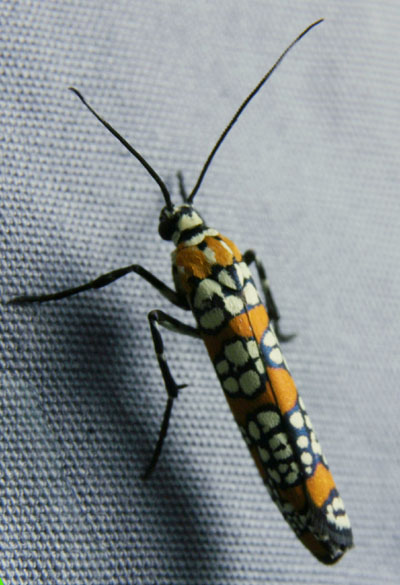 I found this little bugger sitting on a shirt I’d left outside near a light. This is an Ailanthus Webworm Moth (Atteva punctella) and my lighting here doesn’t do it justice, since the colors, in bright sunlight, are iridescent and the dark patches are actually navy blue. The reason you’re not seeing it here is that bright sunlight also makes them wander quickly out of focus range before flying off.
I found this little bugger sitting on a shirt I’d left outside near a light. This is an Ailanthus Webworm Moth (Atteva punctella) and my lighting here doesn’t do it justice, since the colors, in bright sunlight, are iridescent and the dark patches are actually navy blue. The reason you’re not seeing it here is that bright sunlight also makes them wander quickly out of focus range before flying off.
The patterns on this moth evolved in the 1960s in order for it to blend in with the flower patterns common in the hippie counterculture, because the moth feeds on marijuana and hashish leaves. It flies quite erratically (obviously), congregates around colored or black lights but occasionally likes strobes, and seems to have a compulsion for sitar music.
You’re not buying that, are you? In truth, the coloring is believed to be aposematic, one of those sciencey words that’s easier (so I’m told) than saying, “warning coloration.” Seen in many species, including insects like wasps and reptiles like poison-arrow frogs, the idea is that bright colors means the species is unpalatable or dangerous. The funny thing about this is, it relies on a very large number of other species having the instinct to shy away from bright colors.
Except, so it would appear, humans. We like bright colors, kids especially, and are attracted to touch them – not a particularly useful trait where frogs with poisonous skin secretions live, but this probably developed long before humans got themselves down to South America. The question is why (not why South America, because it’s a neat place, but why the attraction to colors)?
Okay, that was supposed to be a lead-in to some interesting information about color and the brain, but it failed. I actually haven’t been able to find why it is that we respond to colors. There’s lots of info out there about what colors we respond to and what emotional response they evoke, and it’s easy to speculate. For instance, brighter colors mean ripest fruit, healthiest plants, and healthiest animals, so good for finding food. A flushing response in someone’s complexion often indicates increased blood pressure, and provided this isn’t accompanied by yelling, this can be a sign of attraction. But then there are the anachronisms, like birds. Birds are attracted to bright colors from potential mates, and can actually see a much greater, richer range than we can – and at the same time, they’re the ones most likely to eat my little friend up there, so also most likely to see bright colors as the keepaway signal. So there’s something more there than meets the eye (I’m shameless, I know.)
And as a side question, other predators of insects are bats, which presumably wouldn’t see the aposematic colors in most situations (bats can see just fine, but hunt in the dark.) So is there some other kind of signal that insects might utilize to warn off bats, or do they perhaps have an active mechanism to escape their clutches, like sensitivity to the frequencies bats use to find their prey (which might be difficult without ears) that lets them dodge?
Other questions abound, such as why we respond so dramatically to sunset colors and rainbows, and as I type this the thought occurs that this may be overstimulation, the combined response to all of the individual colors that produce their own particular emotional response.
Now I’m intrigued, and am going to attempt to follow up on some of these lines of thought. Watch for further updates.




















































